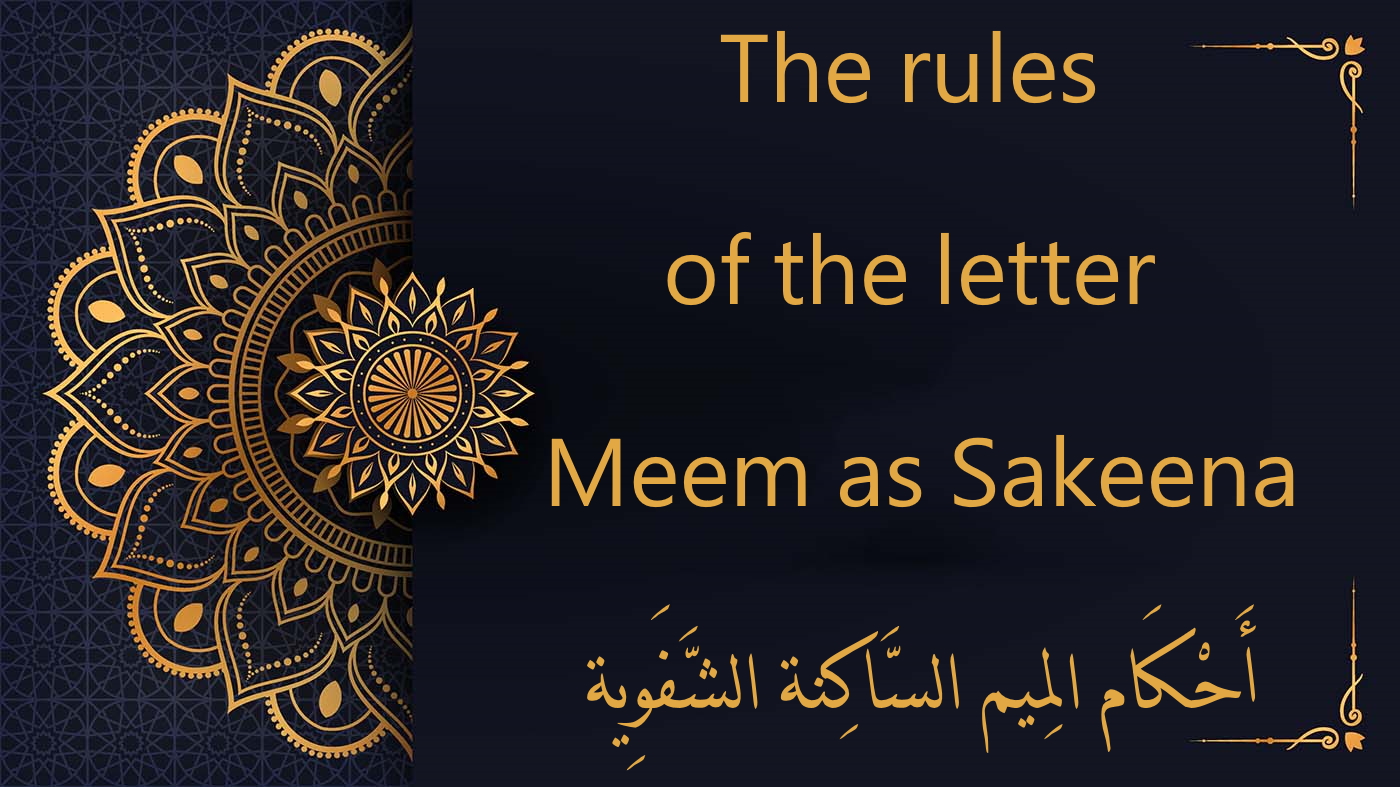
The letter “Mim” (م) and its variant, “Meem As Sakeena” (مْ), are both considered labial letters, which means they are articulated using the contact of the two lips. In the case of “Meem As Sakeena,” when it carries a sukoon and is followed by another letter, there are three fundamental rules that apply to its pronunciation:
الإِخْفاء (Al Ikhfa – Concealment): This rule involves concealing or partially obscuring the pronunciation of the Meem As Sakeena when it is followed by certain letters. It results in a subtle and subdued pronunciation of the Meem As Sakeena without completely suppressing it. The specific letters that trigger Ikhfa are typically “ba” (ب), “ta” (ت), “tha” (ث), “jiim” (ج), “dal” (د), “dhal” (ذ), “ra” (ر), “za” (ز), “sin” (س), and “shin” (ش).
الإدْغَام (Al Idgham – Assimilation): In this rule, the Meem As Sakeena is assimilated or merged with the following letter, resulting in a combined sound. The specific letters that trigger Idgham are “ba” (ب), “ta” (ت), “tha” (ث), “jiim” (ج), “dal” (د), “dhal” (ذ), “kha” (خ), “qaf” (ق), and “fa” (ف). The assimilation may vary in degree depending on the pronunciation style.
الإظْهَار (Al Idhar – The Clarification): In Idhar, the Meem As Sakeena is pronounced clearly and distinctly when followed by certain letters. The letters that trigger Idhar are “lam” (ل), “mim” (م), “noon” (ن), “waw” (و), “ya” (ي), “ha” (هـ), and “ayn” (ع).
These rules are crucial in Tajweed (the science of Quranic recitation) to ensure accurate pronunciation and maintain the melodious flow of the Quranic verses. Proper application of these rules adds depth and precision to Quranic recitation, preserving the beauty and integrity of the holy text.
This rule, known as “Al Ikhfa Ashafawee,” derives its name from the fact that it involves the interaction of two labial, or lip-produced, sounds.
While some scholars of Tajweed have suggested the possibility of applying “Al Idhar” (the clarification) in this context, it’s essential to note that this view remains a minority opinion.
The rule of Al Ikhfa Ashafawee comes into play when the letter “ba” (ب) immediately follows the Meem As Sakeena. In technical terms, this rule calls for the Meem As Sakeena to be pronounced in a manner that falls between “Al Idhar” (the clarification) and “Al Idgham” (assimilation). The key is to execute a full 2-beat nasalization during pronunciation.
Conversely, the vocalized letter “ba” (ب) is pronounced clearly without any nasalization or assimilation. In this case, the lips are positioned without exerting pressure on each other.
It’s important to acknowledge that there exists a scholarly difference of opinion, referred to as “ikhtilaf,” regarding the precise lip positioning in this context. Two methods are considered acceptable:
Pressing the Lips Together: Some scholars advocate for a complete lip closure, where the upper and lower lips touch during pronunciation.
Leaving a Minimal Gap: Others propose a minimal gap between the lips, akin to allowing a thin sheet to pass between them during articulation.
Example:
تَرْمِيهِم بِحِجَارَةٍ مِّن سِجِّيلٍ
Striking them with stones of hard clay, (105:4)
أَلَمْ يَعْلَم بِأَنَّ اللَّـهَ يَرَىٰ
Does he not know that Allah sees? (96:14)
This specific type of Idgham is known as “Al Idgham Al Mutamathilayn” or “Al Idgham Al Mithlayn as Sagheer,” which means the assimilation of two identical letters. This rule applies when the Meem As Sakeena is followed by another “م” (Meem) that carries a harakah, indicating a vowel sound (kasra, fatha, or damma).
Technically, in this case, the two Meem letters merge into one, and the resulting pronunciation includes a shadda (a diacritical mark indicating the doubling of a letter) and a full nasalization lasting for 2 beats. To achieve this, pressure is applied to both lips during pronunciation.
It’s important to note that while the second Meem carries a shadda in the Quranic script, Arabic words typically do not begin with a shadda. This serves as a visual cue in Quranic writing, indicating that the rule of “Al Idgham Ash-Shafawee” (labial assimilation) should be applied in pronunciation.
Example:
فِي قُلُوبِهِم مَّرَضٌ فَزَادَهُمُ اللَّـهُ مَرَضًا
In their hearts is a disease, so Allah has increased their disease; (2:10)
الَّذِي أَطْعَمَهُم مِّن جُوعٍ وَآمَنَهُم مِّنْ خَوْفٍ
Who has fed them, [saving them] from hunger and made them safe, [saving them] from fear. (106:4)
إِنَّهَا عَلَيْهِم مُّؤْصَدَةٌ
Indeed, Hellfire will be closed down upon them (104:8)
This rule, known as “Al Idhar Ash-Shafawee,” comes into play when the Meem As Sakeena is followed by any of the other 12 letters in the Arabic alphabet, which are as follows:
ا – ت – ث – ج – ح – خ – د – ذ – ر – ز – س – ش – ص ض – ط – ظ – ع – غ – ف – ق – ك – ل – ن – ه – و – ي
Technically, when the Meem As Sakeena is followed by any of these 12 letters, it is pronounced normally and distinctly without a 2-beat ghunna. The ghunna, in this case, is reduced or partial, and the following letter is pronounced with clarity.
This reduction in the ghunna occurs because the Meem As Sakeena and the remaining 12 letters share the same exit point or “makhradj.” This shared point of articulation allows for a smoother transition between the letters, resulting in a natural ghunna of 1 time.
Examples:
لَمْ يَلِدْ وَلَمْ يُولَدْ
He neither begets nor is born (112:3)
وَلَا أَنتُمْ عَابِدُونَ مَا أَعْبُدُ ﴿٥﴾ لَكُمْ دِينُكُمْ وَلِيَ دِينِ
Nor will you be worshippers of what I worship. For you is your religion, and for me, is my religion.” (109-5 and 6)
Important Note: The strength of the clarification (Al Idhar) becomes more pronounced when the Meem As Sakeena is followed by the letters “waw” (و) and “fa” (ف). This is because both “waw” and “fa” share the same exit point, which is also the lips, making it easier for the reader to inadvertently conceal the letter “meem.”
As a result, when encountering the combination of Meem As Sakeena followed by “waw” (و) or “fa” (ف), special care should be taken to pronounce the Meem As Sakeena more distinctly. This emphasis helps avoid any accidental application of “ikhfa” (concealment).
Example:
تَلْفَحُ وُجُوهَهُمُ النَّارُ وَهُمْ فِيهَا كَالِحُونَ
The Fire will sear their faces, and they therein will have taut smiles. (23:104)
صِرَاطَ الَّذِينَ أَنْعَمْتَ عَلَيْهِمْ غَيْرِ الْمَغْضُوبِ عَلَيْهِمْ وَلَا الضَّالِّينَ
The path of those upon whom You have bestowed favour, not of those who have evoked [Your] anger or of those who are astray. (1:7)
This Tajweed rules lesson has concluded. Insha’Allah, the next lesson will cover the rules of prolongations.
At the Al-dirassa Institute, we provide an accessible path to mastering Tajweed under the guidance of skilled instructors. Should you wish to pursue this further, we warmly invite you to reach out to us.
Discover the experiences of our delighted clients who have thoroughly enjoyed utilizing this standout feature.
Alhamdulillah I‘m very pleased with the arabic and Qur’an lessons I receive from teacher Umm Tasneem and I‘m also content with the al-dirassa administration team who were very quick in answering any questions I had. In a month I progressed a lot and I cannot wait to continue my studies with al-dirassa. May Allah reward everyone at al-dirassa.
Verified review - view original
My Qur’an teacher is fantastic, she teaches me in a loving and kind way where I look forward to the lessons and learn so much. My Arabic teacher is equally as nice and has a lot of patience with me, she has great expertise in the field and I’ve progressed really quickly with her. Thank you Al-dirassa!
Verified review - view original
Don’t want to go through the translation anymore?
30 free minutes with your qualified Egyptian teacher.
Al-dirassa center (Markaz ad-dirassa in Arabic) is an institute specialized in the online tuition of the literal Arabic language, the memorization, and the recitation of the Holy Quran as well as the Islamic sciences by distance courses via Skype and Zoom.

Al-dirassa Institute offers you a gift to help you begin your journey to being fluent in Arabic and learning the Quran.

Al-dirassa Institute offers you a gift to help you begin your journey to being fluent in Arabic and learning the Quran.